Sentinel-1 InSAR and GPS-Integrated Long-Term and Seasonal Subsidence Monitoring in Houston, Texas, USA
Abstract
1. Introduction
2. Data and Processing
2.1. Groundwater-Level Data
2.2. GPS Data
2.3. InSAR Data
- Smoothing the three components (east-west, north-south, and up-down directions, abbreviated as ENU) of daily GPS-derived time series (with respect to IGS14) with a 6-day Gaussian filter to minimize the multipath and tropospheric errors.
- Projecting the GPS-derived ENU displacements at 27 selected long-history GPS (>7 years) sites to the LOS direction according to the SAR look angles at each site (see Figure 1 for GPS locations).
- Estimating the errors superimposed into the uncorrected InSAR displacements caused by atmospheric delay. Firstly, the difference between the GPS-derived LOS-displacement and co-located InSAR-derived LOS-displacement during the same time window is calculated at each GPS site. The InSAR-derived LOS-displacement is obtained by averaging the measurement within a 5-pixel by 5-pixel grid (approximately 300 m by 300 m) centered on the GPS site. Secondly, a smooth residual surface is formed using the differences obtained from the first step. We employ the module “surface” in the Generic Mapping Tools (GMT) package [34] to produce the time series of the residual surface, which represents the errors in each uncorrected interferogram caused by atmospheric delay and other sources.
- Correcting each uncorrected interferogram with the residual surface (see Figure 3 for an example).
- Constructing InSAR LOS-displacement time series from all corrected 543 ascending and 756 descending interferograms using a coherence-based small baseline subset (SBAS) approach [35].
- Aligning the LOS-displacement time series to a stable regional reference frame by removing the average LOS-displacement of these 27 reference sites at each time (day).
- Aligning the ENU displacement time series to the stable Houston Reference Frame 2020 according to the average ENU site velocities (with respect to Houston20) at these 27 reference GPS sites.
2.4. Validation of LOS Velocities
3. Results
3.1. GInSAR-Derived Long-Term Subsidence Trend
3.2. Inter-Annual Subsidence
3.3. Seasonal Subsidence
Seasonal Amplitude Variations
4. Discussion
4.1. Accuracy
4.2. Near-Real-Time Monitoring
5. Conclusions
Author Contributions
Funding
Data Availability Statement
Acknowledgments
Conflicts of Interest
References
- Census Bureau. Statistical Abstract of the United States; U.S. Government Printing Office: Washington, DC, USA, 2009; ISBN 9780160838859.
- Coplin, L.S.; Galloway, D. Houston-Galveston, Texas: Managing coastal subsidence. In Land Subsidence in the United States; Galloway, D., Jones, D.R., Ingebritsen, S.E., Eds.; U.S. Geological Survey: Reston, VA, USA, 1999; Volume 1182, pp. 35–48. [Google Scholar]
- Turco, M.J.; Petrov, A. Effects of groundwater regulation on aquifer-system compaction and subsidence in the Houston-Galveston Region, Texas, USA. Proc. Int. Assoc. Hydrol. Sci. 2015, 372, 511–514. [Google Scholar] [CrossRef]
- Kasmarek, M.C.; Gabrysch, R.K.; Johnson, M.R. Estimated Land-Surface Subsidence in Harris County, Texas, 1915–1917 to 2001; US Department of the Interior: Washington, DC, USA; US Geological Survey: Reston, VA, USA, 2009.
- Greuter, A.; Turco, M.J.; Petersen, C.M.; Wang, G. Impacts of Groundwater Withdrawal Regulation on Subsidence in Harris and Galveston Counties, Texas, 1978–2020. GeoGulf Trans. 2021, 71, 109–118. [Google Scholar]
- Kearns, T.J.; Wang, G.; Bao, Y.; Jiang, J.; Lee, D. Current Land Subsidence and Groundwater Level Changes in the Houston Metropolitan Area (2005–2012). J. Surv. Eng. 2015, 141, 05015002. [Google Scholar] [CrossRef]
- Baker, E.T., Jr. Stratigraphic and Hydrogeologic Framework of Part of the Coastal Plain of Texas; Texas Department of Water Resources: Austin, TX, USA, 1979; Volume 236, p. 43.
- Zhou, X.; Wang, G.; Wang, K.; Liu, H.; Lyu, H.; Turco, M.J. Rates of Natural Subsidence along the Texas Coast Derived from GPS and Tide Gauge Measurements (1904–2020). J. Surv. Eng. 2021, 147, 04021020. [Google Scholar] [CrossRef]
- Wang, G.; Welch, J.L.; Kearns, T.J.; Yang, L.; Serna, J., Jr. Introduction to GPS geodetic infrastructure for land subsidence monitoring in Houston, Texas, USA. Proc. Int. Assoc. Hydrol. Sci. 2015, 372, 297–303. [Google Scholar] [CrossRef][Green Version]
- Wang, G.; Turco, M.; Soler, T.; Kearns, T.J.; Welch, J. Comparisons of OPUS and PPP Solutions for Subsidence Monitoring in the Greater Houston Area. J. Surv. Eng. 2017, 143, 5017005. [Google Scholar] [CrossRef]
- Wang, G.; Greuter, A.; Petersen, C.M.; Turco, M.J. Houston GNSS Network for Subsidence and Faulting Monitoring: Data Analysis Methods and Products. J. Surv. Eng. 2022, 148, 04022008. [Google Scholar] [CrossRef]
- Galloway, D.L.; Hudnut, K.W.; Ingebritsen, S.E.; Phillips, S.P.; Peltzer, G.; Rogez, F.; Rosen, P.A. Detection of aquifer system compaction and land subsidence using interferometric synthetic aperture radar, Antelope Valley, Mojave Desert, California. Water Resour. Res. 1998, 34, 2573–2585. [Google Scholar] [CrossRef]
- Amelung, F.; Galloway, D.; Bell, J.W.; Zebker, H.A.; Laczniak, R.J. Sensing the ups and downs of Las Vegas: InSAR reveals structural control of land subsidence and aquifer-system deformation. Geology 1999, 27, 483–486. [Google Scholar] [CrossRef]
- Chaussard, E.; Wdowinski, S.; Cabral-Cano, E.; Amelung, F. Land subsidence in central Mexico detected by ALOS InSAR time-series. Remote Sens. Environ. 2014, 140, 94–106. [Google Scholar] [CrossRef]
- Perissin, D.; Wang, T. Time-Series InSAR Applications Over Urban Areas in China. IEEE J. Sel. Top. Appl. Earth Obs. Remote Sens. 2010, 4, 92–100. [Google Scholar] [CrossRef]
- Buckley, S.M.; Rosen, P.A.; Hensley, S.; Tapley, B. Land subsidence in Houston, Texas, measured by radar interferometry and constrained by extensometers. J. Geophys. Res. Earth Surf. 2003, 108, 2542. [Google Scholar] [CrossRef]
- Bawden, G.W.; Johnson, M.R.; Kasmarek, M.C.; Brandt, J.T.; Middleton, C.S. Investigation of Land Subsidence in the Houston-Galveston Region of Texas by Using the Global Positioning System and In-terferometric Synthetic Aperture Radar, 1993–2000; US Geological Survey Scientific Investigations Report 2012-5211; U.S. Geological Survey: Reston, VA, USA, 2012.
- Khan, S.D.; Huang, Z.; Karacay, A. Study of ground subsidence in northwest Harris county using GPS, LiDAR, and InSAR techniques. Nat. Hazards 2014, 73, 1143–1173. [Google Scholar] [CrossRef]
- Qu, F.; Lu, Z.; Zhang, Q.; Bawden, G.W.; Kim, J.-W.; Zhao, C.; Qu, W. Mapping ground deformation over Houston–Galveston, Texas using multi-temporal InSAR. Remote Sens. Environ. 2015, 169, 290–306. [Google Scholar] [CrossRef]
- Khan, S.D.; Gadea, O.C.A.; Alvarado, A.T.; Tirmizi, O.A. Surface Deformation Analysis of the Houston Area Using Time Series Interferometry and Emerging Hot Spot Analysis. Remote Sens. 2022, 14, 3831. [Google Scholar] [CrossRef]
- Casu, F.; Buckley, S.; Manzo, M.; Pepe, A.; Lanari, R. Large scale InSAR deformation time series: Phoenix and Houston case studies. In Proceedings of the 2005 IEEE International Geoscience and Remote Sensing Symposium, Seoul, Republic of Korea, 29 July 2005; pp. 5240–5243. [Google Scholar] [CrossRef]
- Braun, C.L.; Ramage, J.K. Status of water-level altitudes and long-term water-level changes in the Chicot and Evangeline (undifferentiated) and Jasper aquifers, greater Houston area, Texas, 2021. In Scientific Investigations Report; U.S. Geological Survey: Reston, VA, USA, 2022. [Google Scholar] [CrossRef]
- USGS Groundwater Data for the Nation. Available online: https://waterdata.usgs.gov/nwis/gw (accessed on 3 December 2022).
- Agudelo, G.; Wang, G.; Liu, Y.; Bao, Y.; Turco, M.J. GPS geodetic infrastructure for subsidence and fault monitoring in Houston, Texas, USA. Proc. Int. Assoc. Hydrol. Sci. 2020, 382, 11–18. [Google Scholar] [CrossRef]
- Harris-Galveston Subsidence District. Available online: https://hgsubsidence.org (accessed on 3 December 2022).
- Wang, G. The 95% Confidence Interval for GNSS-Derived Site Velocities. J. Surv. Eng. 2022, 148, 04021030. [Google Scholar] [CrossRef]
- Sandwell, D.T.; Mellors, R.J.; Tong, X.; Wei, M.; Wessel, P. Open radar interferometry software for mapping surface Deformation. Eos 2011, 92, 234. [Google Scholar] [CrossRef]
- Farr, T.G.; Rosen, P.A.; Caro, E.; Crippen, R.; Duren, R.; Hensley, S.; Kobrick, M.; Paller, M.; Rodriguez, E.; Roth, L.; et al. The Shuttle Radar Topography Mission. Rev. Geophys. 2007, 45, RG2004. [Google Scholar] [CrossRef]
- Sentinel1 Orbit State Vectors. Available online: https://s1qc.asf.alaska.edu/aux_poeorb/ (accessed on 17 October 2022).
- Chen, C.W.; Zebker, H.A. Phase unwrapping for large SAR interferograms: Statistical segmentation and generalized network models. IEEE Trans. Geosci. Remote Sens. 2002, 40, 1709–1719. [Google Scholar] [CrossRef]
- Hanssen, R.F. Radar Interferometry: Data Interpretation and Error Analysis; Springer Science & Business Media: New York, NY, USA, 2001; ISBN 9780792369455. [Google Scholar]
- Zebker, H.A.; Rosen, P.A.; Hensley, S. Atmospheric effects in interferometric synthetic aperture radar surface deformation and topographic maps. J. Geophys. Res. Solid Earth 1997, 102, 7547–7563. [Google Scholar] [CrossRef]
- Neely, W.R.; Borsa, A.A.; Silverii, F. GInSAR: A cGPS Correction for Enhanced InSAR Time Series. IEEE Trans. Geosci. Remote Sens. 2019, 58, 136–146. [Google Scholar] [CrossRef]
- Wessel, P.; Luis, J.F.; Uieda, L.; Scharroo, R.; Wobbe, F.; Smith, W.H.F.; Tian, D. The Generic Mapping Tools Version 6. Geochem. Geophys. Geosystems 2019, 20, 5556–5564. [Google Scholar] [CrossRef]
- Berardino, P.; Fornaro, G.; Lanari, R.; Sansosti, E. A new algorithm for surface deformation monitoring based on small baseline differential SAR interferograms. IEEE Trans. Geosci. Remote. Sens. 2002, 40, 2375–2383. [Google Scholar] [CrossRef]
- Fuhrmann, T.; Garthwaite, M.C. Resolving Three-Dimensional Surface Motion with InSAR: Constraints from Multi-Geometry Data Fusion. Remote Sens. 2019, 11, 241. [Google Scholar] [CrossRef]
- Wang, K.; Wang, G.; Cornelison, B.; Liu, H.; Bao, Y. Land subsidence and aquifer compaction in Montgomery County, Texas, U.S.: 2000–2020. Geoenvironmental Disasters 2021, 8, 1–24. [Google Scholar] [CrossRef]
- Liu, Y.; Sun, X.; Wang, G.; Turco, M.J.; Agudelo, G.; Bao, Y.; Zhao, R.; Shen, S. Current Activity of the Long Point Fault in Houston, Texas Constrained by Continuous GPS Measurements (2013–2018). Remote Sens. 2019, 11, 1213. [Google Scholar] [CrossRef]
- Wang, G. New Preconsolidation Heads Following the Long-Term Hydraulic-Head Decline and Recovery in Houston, Texas. Ground Water 2022. online ahead of print. [Google Scholar] [CrossRef]
- Wang, G. Seasonal Subsidence and Heave Recorded by Borehole Extensometers in Houston. J. Surv. Eng. 2022, 149, 1. [Google Scholar] [CrossRef]
- Lu, Z.; Danskin, W.R. InSAR analysis of natural recharge to define structure of a ground-water basin, San Bernardino, California. Geophys. Res. Lett. 2001, 28, 2661–2664. [Google Scholar] [CrossRef]
- Reeves, J.A.; Knight, R.; Zebker, H.A.; Schreüder, W.A.; Agram, P.S.; Lauknes, T.R. High quality InSAR data linked to seasonal change in hydraulic head for an agricultural area in the San Luis Valley, Colorado. Water Resour. Res. 2011, 47, W12510. [Google Scholar] [CrossRef]
- Miller, M.M.; Shirzaei, M.; Argus, D. Aquifer Mechanical Properties and Decelerated Compaction in Tucson, Arizona. J. Geophys. Res. Solid Earth 2017, 122, 8402–8416. [Google Scholar] [CrossRef]
- Hu, X.; Lu, Z.; Wang, T. Characterization of Hydrogeological Properties in Salt Lake Valley, Utah, using InSAR. J. Geophys. Res. Earth Surf. 2018, 123, 1257–1271. [Google Scholar] [CrossRef]
- Peng, M.; Lu, Z.; Zhao, C.; Motagh, M.; Bai, L.; Conway, B.D.; Chen, H. Mapping land subsidence and aquifer system properties of the Willcox Basin, Arizona, from InSAR observations and independent component analysis. Remote Sens. Environ. 2022, 271, 112894. [Google Scholar] [CrossRef]
- Qu, F.; Lu, Z.; Kim, J.-W.; Zheng, W. Identify and Monitor Growth Faulting Using InSAR over Northern Greater Houston, Texas, USA. Remote Sens. 2019, 11, 1498. [Google Scholar] [CrossRef]
- ESA Copernicus Open Access Hub. Available online: https://scihub.copernicus.eu/dhus/#/home (accessed on 3 December 2022).
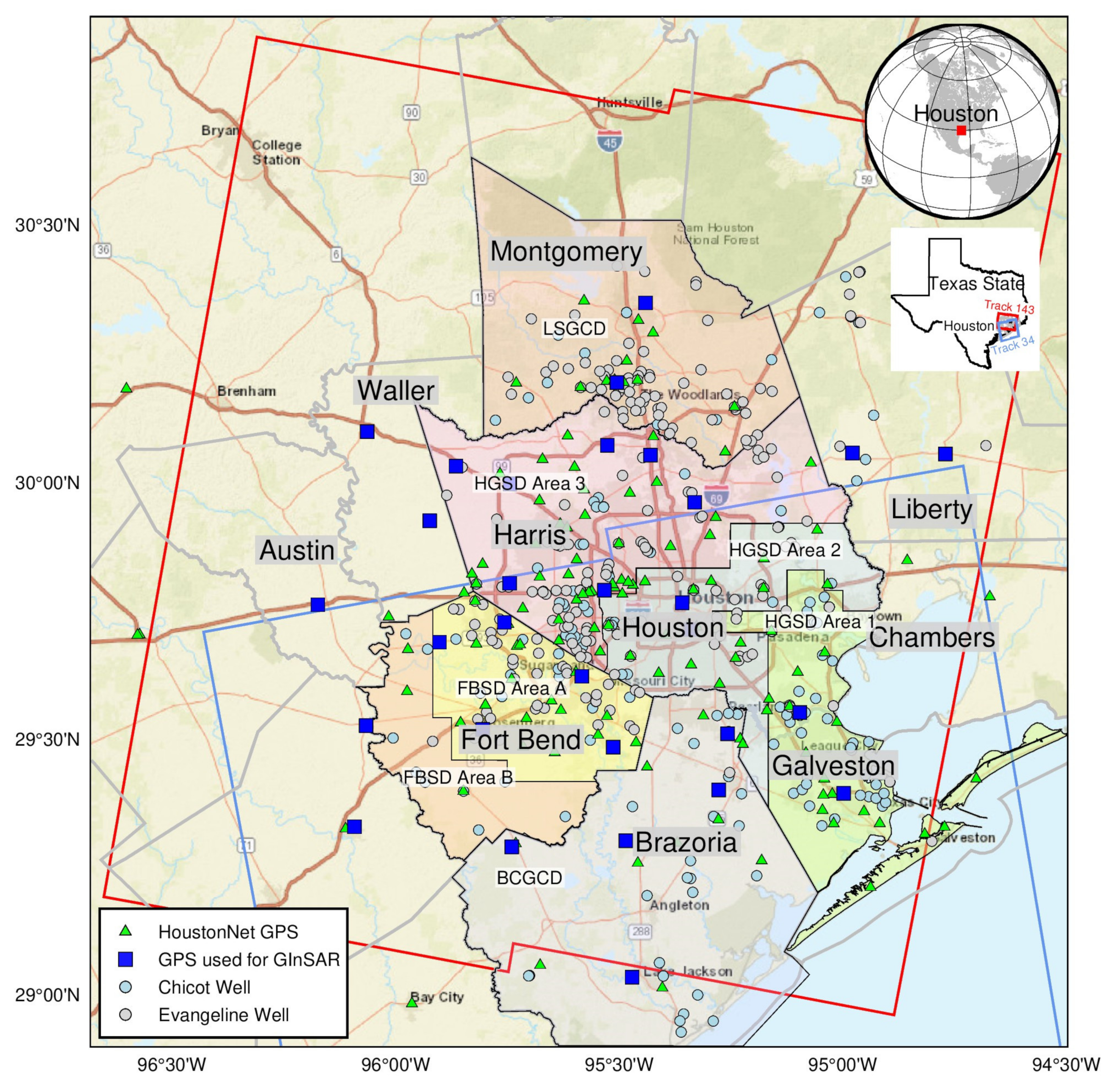
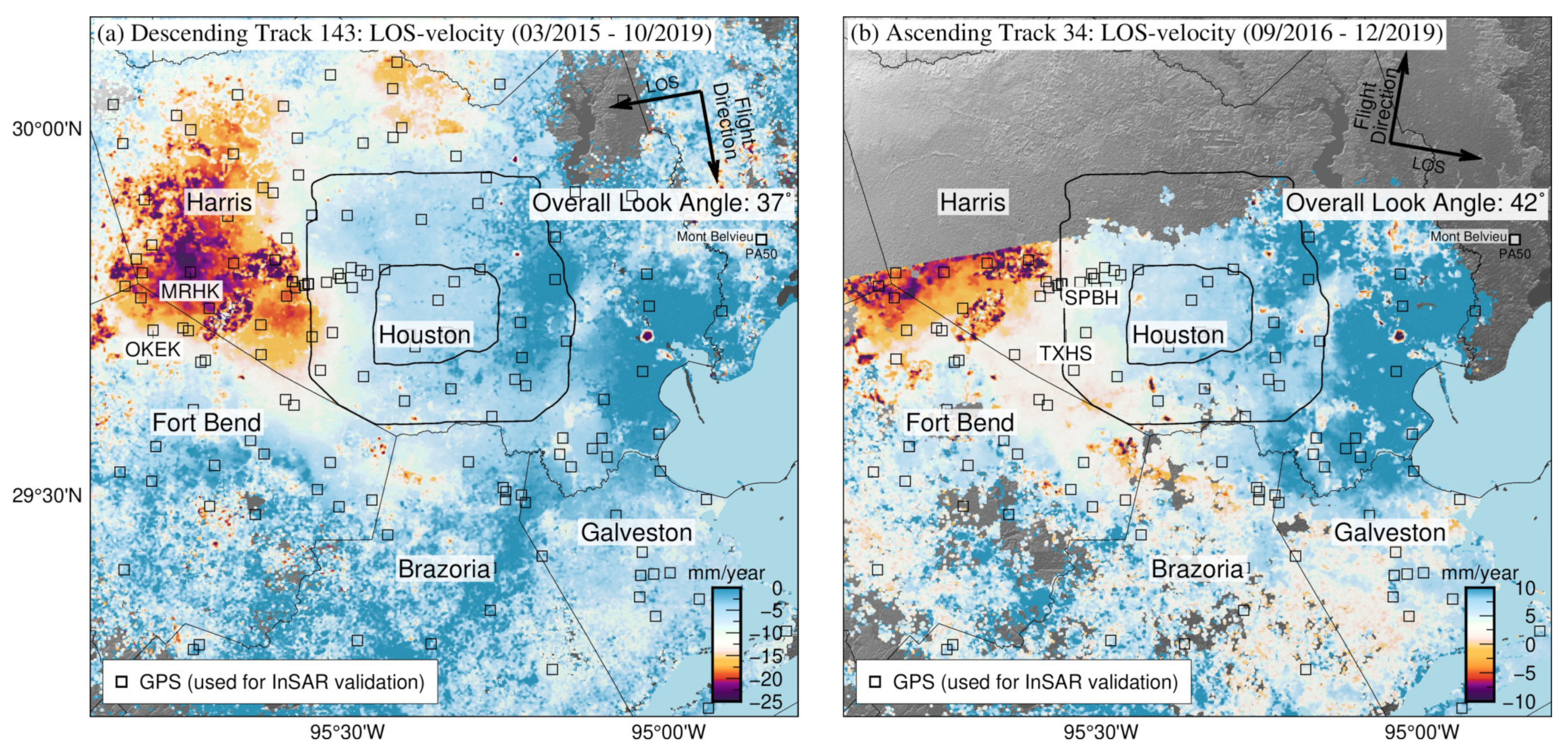



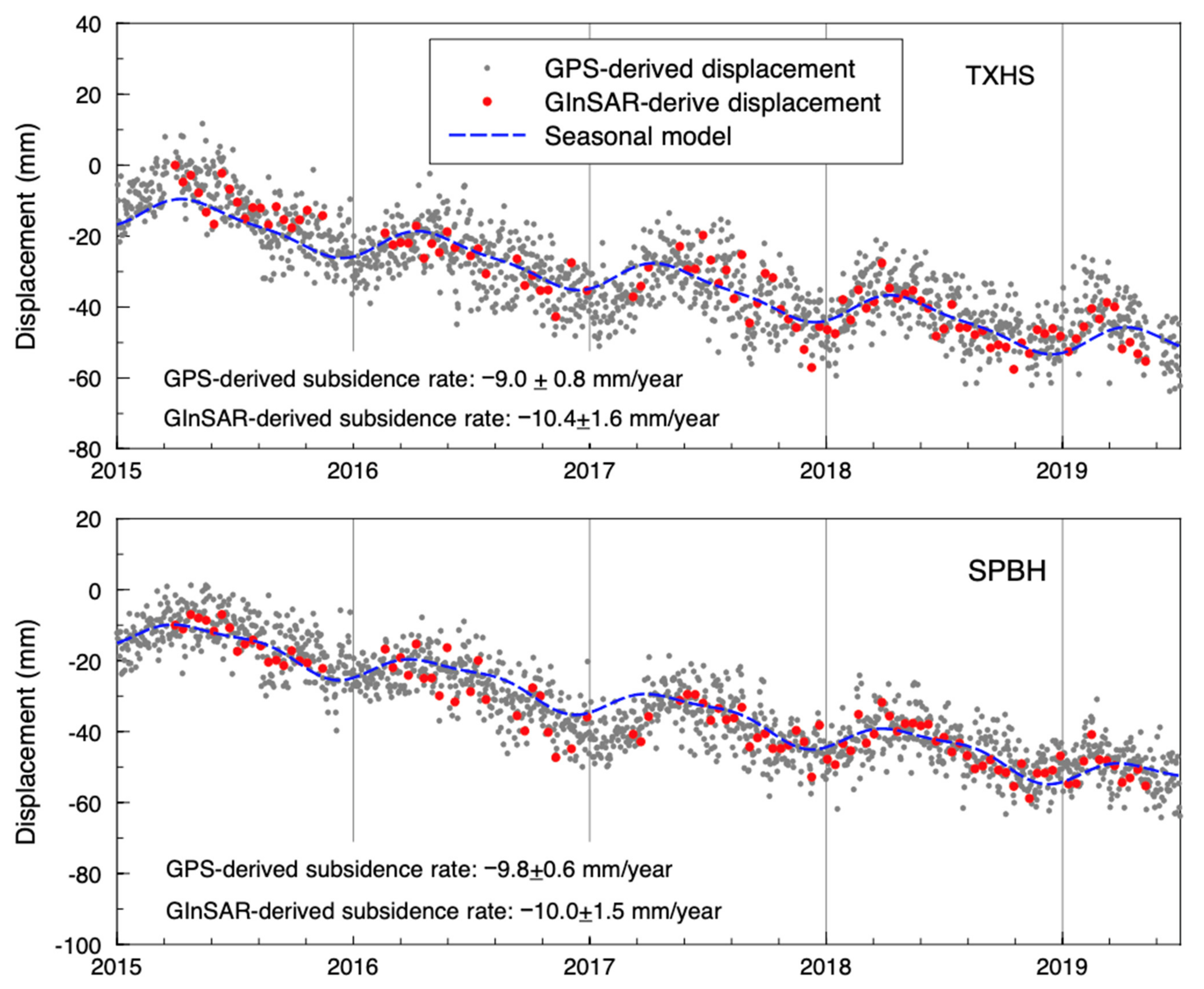
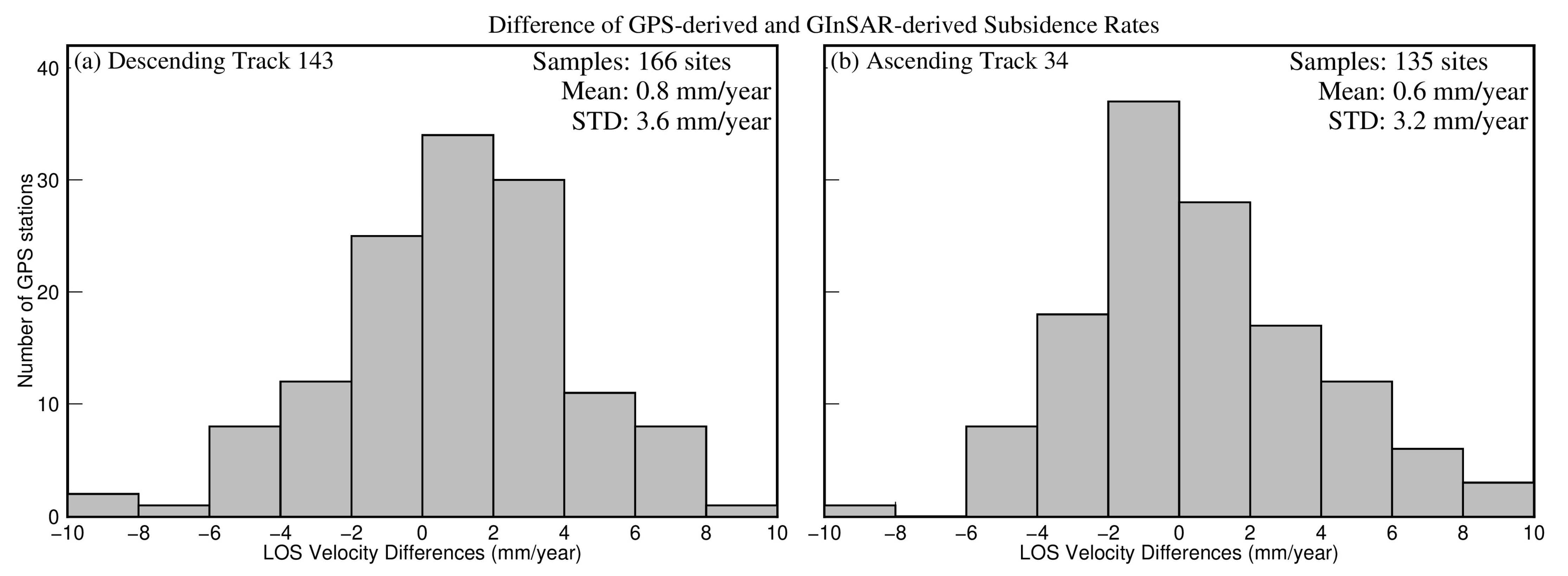

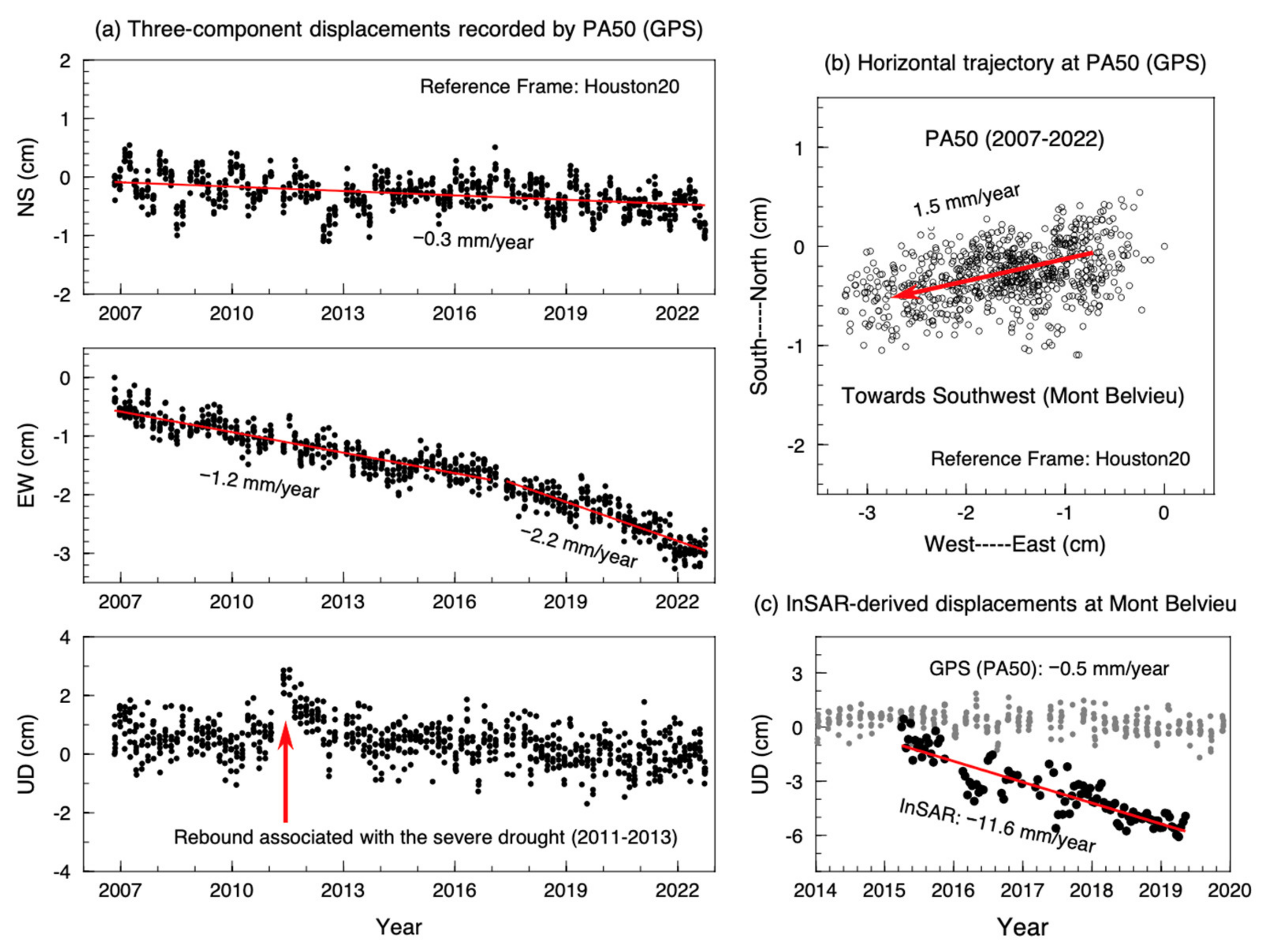
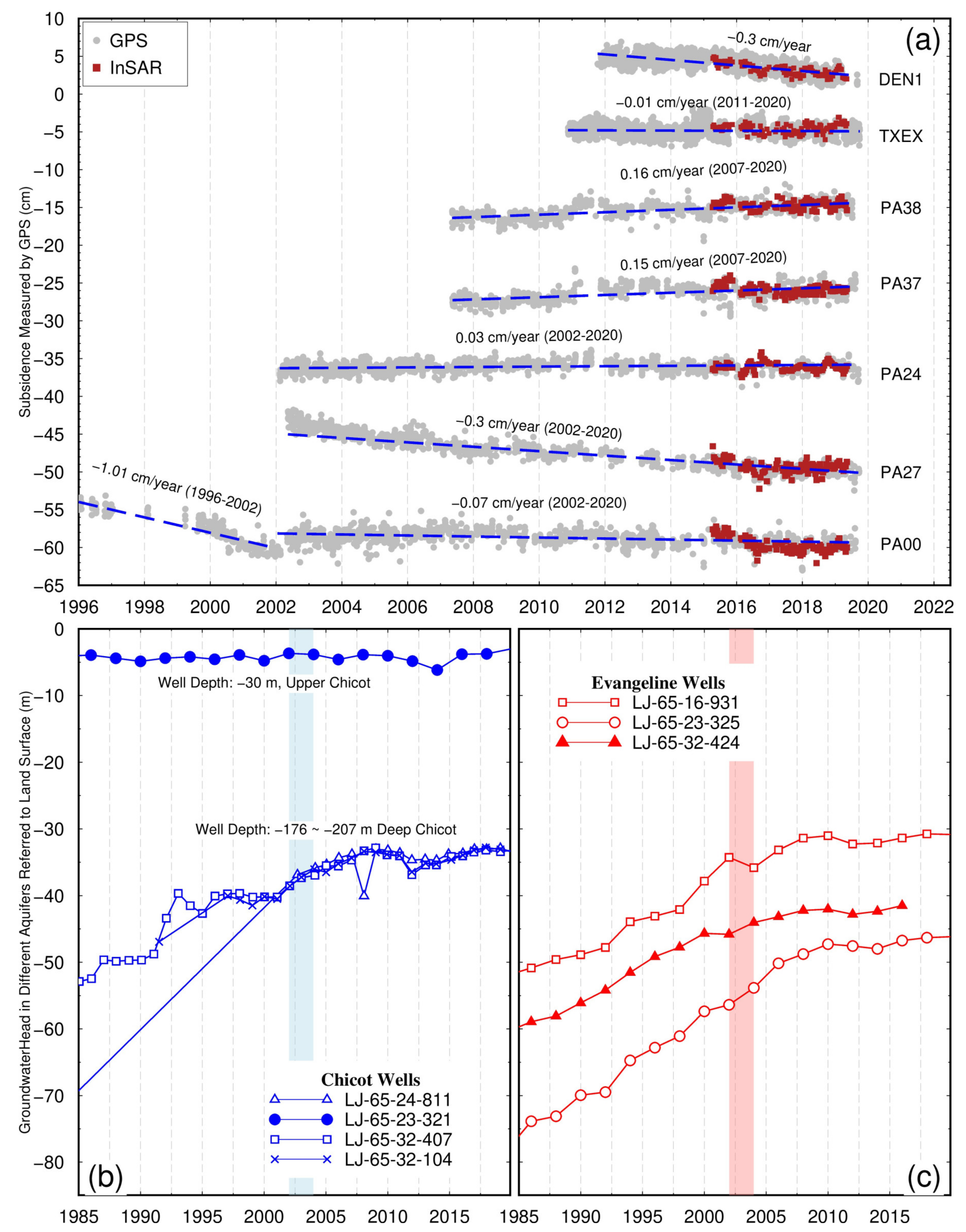

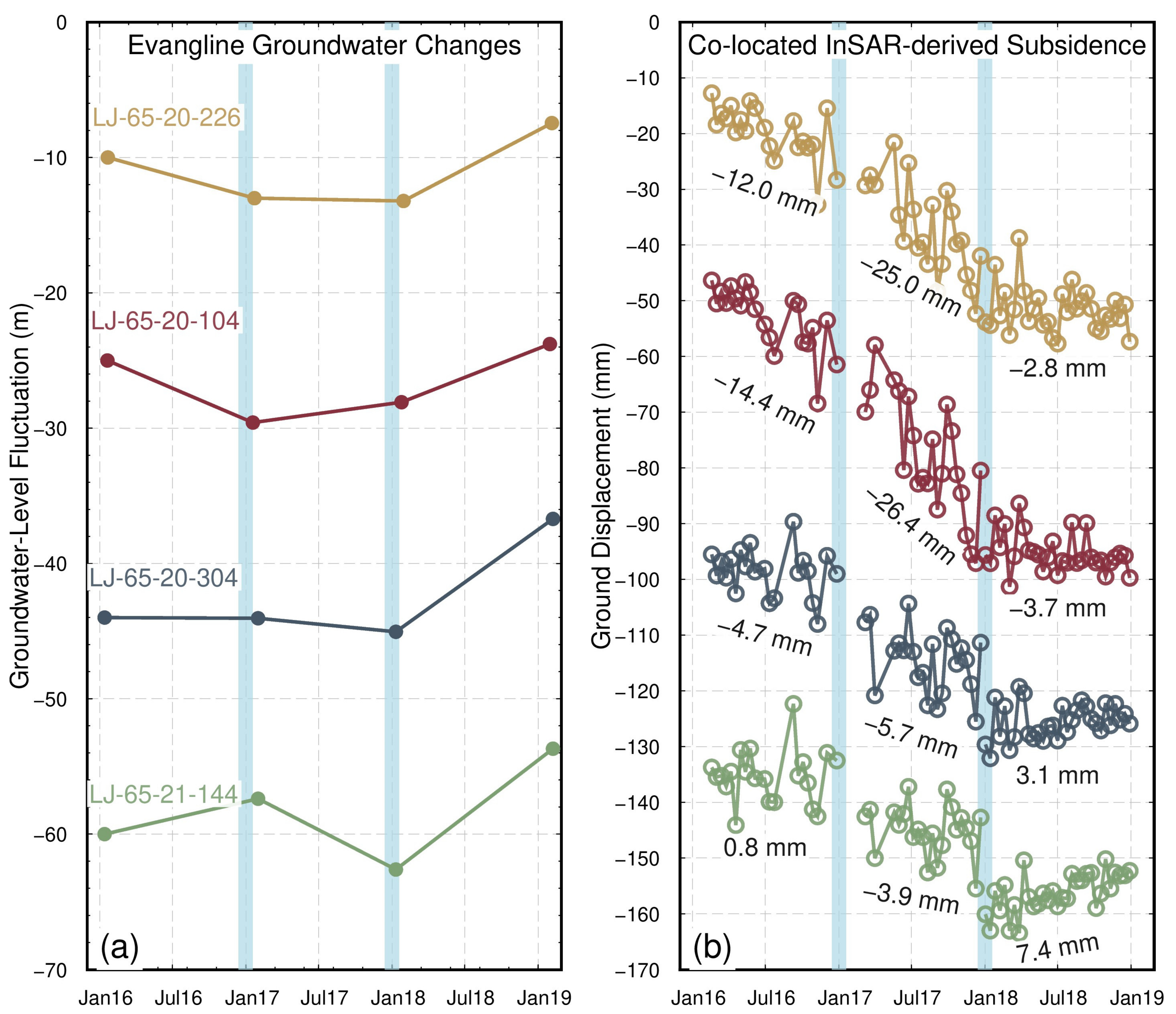


Publisher’s Note: MDPI stays neutral with regard to jurisdictional claims in published maps and institutional affiliations. |
© 2022 by the authors. Licensee MDPI, Basel, Switzerland. This article is an open access article distributed under the terms and conditions of the Creative Commons Attribution (CC BY) license (https://creativecommons.org/licenses/by/4.0/).
Share and Cite
Liu, Y.; Wang, G.; Yu, X.; Wang, K. Sentinel-1 InSAR and GPS-Integrated Long-Term and Seasonal Subsidence Monitoring in Houston, Texas, USA. Remote Sens. 2022, 14, 6184. https://doi.org/10.3390/rs14236184
Liu Y, Wang G, Yu X, Wang K. Sentinel-1 InSAR and GPS-Integrated Long-Term and Seasonal Subsidence Monitoring in Houston, Texas, USA. Remote Sensing. 2022; 14(23):6184. https://doi.org/10.3390/rs14236184
Chicago/Turabian StyleLiu, Yuhao, Guoquan Wang, Xiao Yu, and Kuan Wang. 2022. "Sentinel-1 InSAR and GPS-Integrated Long-Term and Seasonal Subsidence Monitoring in Houston, Texas, USA" Remote Sensing 14, no. 23: 6184. https://doi.org/10.3390/rs14236184
APA StyleLiu, Y., Wang, G., Yu, X., & Wang, K. (2022). Sentinel-1 InSAR and GPS-Integrated Long-Term and Seasonal Subsidence Monitoring in Houston, Texas, USA. Remote Sensing, 14(23), 6184. https://doi.org/10.3390/rs14236184








